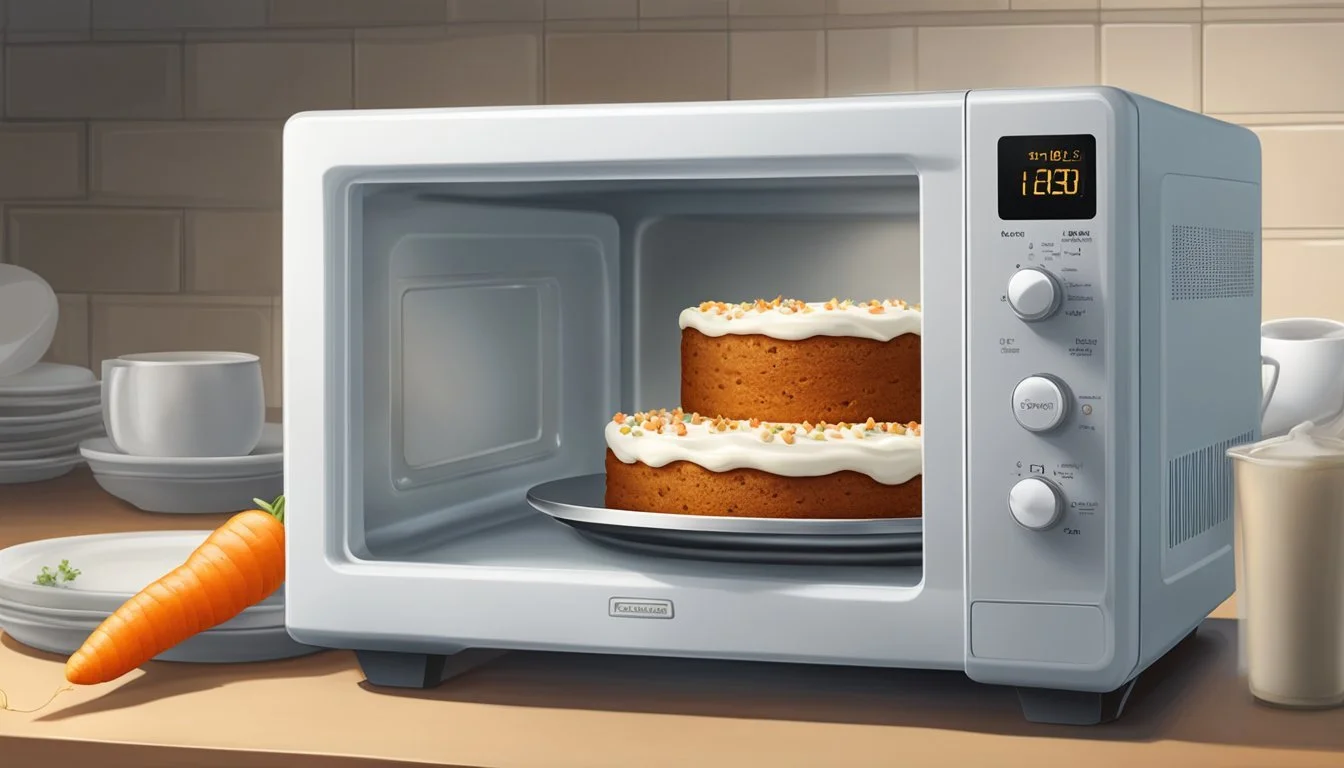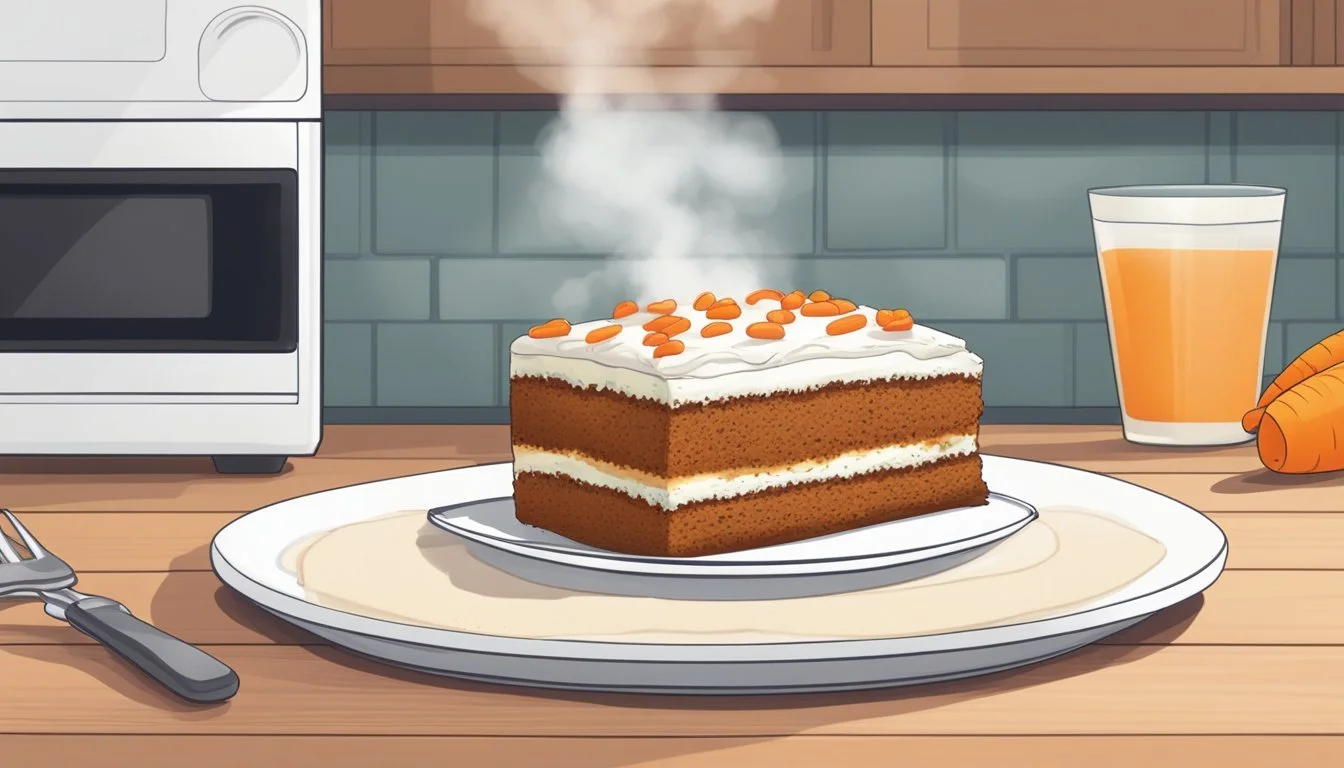Best Way to Reheat a Carrot Cake to Keep It Moist
Expert Tips for a Perfect Dessert
Carrot cake's popularity endures in part due to its moist texture, rich flavor, and creamy frosting. However, maintaining that delightful moisture can be challenging, especially when reheating slices after they've cooled off or been stored in the refrigerator. As carrot cake enthusiasts know, serving it at just the right temperature enhances both the cake's flavor and texture, ensuring a satisfying experience with each bite.
When it comes to reheating carrot cake, the key is to employ methods that reintroduce heat without drying it out. Care must be taken to preserve its delectable moistness, which sets it apart from other desserts. This is especially crucial if the cake comes with its traditional cream (how long does cream last?) cheese frosting, which requires gentle handling to retain its smooth and luscious quality.
There are several effective techniques to warm a carrot cake that not only keep it moist but may also improve its overall flavor. These include using the oven, microwave, or steam-based methods, each suited for different situations and levels of convenience. Understanding the nuances of these reheating methods ensures that the carrot cake remains as enjoyable as when it was first baked.
Why Reheating Carrot Cake Properly Matters
Reheating carrot cake is not just about warming up a dessert; it's about preserving its delectable moisture, texture, and taste. Carrot cake, known for its moist crumb and rich flavor, can become dry and unappealing if reheated incorrectly.
Moisture is perhaps the most crucial element in a carrot cake. It should retain its original moistness even after reheating. The proper method ensures that the moisture is locked in, preventing a dry or crumbly texture.
The texture of carrot cake is a delicate balance. An optimal reheating technique maintains the fluffiness while preventing the cake from becoming too dense or gummy. This preserves the enjoyable mouthfeel that is characteristic of a well-made carrot cake.
Taste, the ultimate measure of a carrot cake's success, is deeply influenced by its moisture and texture. Reheating should amplify the flavors of spices, carrots (how long do carrots last?), and nuts rather than diminishing them.
Below are the key reasons why reheating carrot cake properly matters:
Preserves Moisture: Prevents drying out, maintaining the cake's delightful moisture.
Maintains Texture: Keeps the delicate crumb intact, ensuring the cake is fluffy, not dense or tough.
Enhances Flavor: Proper reheating technique allows the intricate blend of spices and carrot flavors to shine.
One's approach to reheating can make the difference between a merely edible piece of carrot cake and an enjoyable, comforting dessert that tastes as good as when it was first served.
Pre-Reheating Steps
Before reheating a carrot cake, certain precautions are vital to retain its moisture and quality. These initial steps ensure the process is conducive to delivering a carrot cake that's as delicious as when first served.
Bringing to Room Temperature
Carrot cake with cream cheese frosting should be brought to room temperature before reheating. Cakes (how long do cakes last?) stored in the fridge should sit out for about 30 minutes so the cake and frosting soften evenly, reducing the chances of overheating.
Assessing the Cake Condition
Inspect the carrot cake carefully for any signs of dryness. If the cake appears dry, one may consider applying a simple syrup before reheating. A cake that has been properly wrapped in plastic wrap should retain moisture better than one exposed to air.
Prepping for Reheat
To prepare for reheating, if not frosted, one can tent the cake with foil to keep in moisture. For cake with cream cheese frosting, reheating uncovered is best to avoid the frosting from melting onto the wrapping. Always remove plastic wrap prior to warming.
Reheating Methods
When reheating carrot cake, the goal is to restore its moist texture without overcooking. This section details three effective methods, each with its own benefits.
Oven Reheating for Optimal Moistness
Preheating the oven to 350°F is the first step in the oven method. The user should then wrap individual slices of carrot cake in aluminum foil to prevent them from drying out. This creates a steamy environment that retains moisture. The cake should bake in the preheated oven for about 10 minutes.
Preheat: 350°F (175°C)
Wrap: Aluminum foil
Bake Time: 10 minutes
Microwave Method for Quick Reheat
For a quick solution, the microwave can be used, but care is necessary to avoid a rubbery texture. Place a slice of carrot cake on a microwave-safe dish and cover it with a microwave-safe lid or damp paper towel to keep the moisture in. Heat on medium power in 30-second intervals, checking for warmth and moistness.
Power: Medium
Intervals: 30 seconds
Cover: Microwave-safe lid/damp paper towel
Steam Technique for Even Heat
The steam method involves heating water in a pot until it simmers. Place a steam basket or colander above the water and put the cake inside, without letting it touch the water. Cover with a lid and let the cake steam for a few minutes until warm and moist. This technique helps the cake retain even moisture throughout.
Simmer Water: Don't let cake touch the water
Cover: Lid over the steam basket/colander
Steam Time: A few minutes until warm
Handling Frosting
When reheating carrot cake, one must ensure that the frosting, particularly if it's cream cheese-based, retains its creamy texture and flavor. This section will detail specific techniques to handle frosting effectively.
Cream Cheese Frosting Tips
Cream cheese frosting should always be dealt with carefully, as it is prone to melting. To preserve its consistency, one must remove the frosting from the carrot cake before reheating the cake itself. Here's how one should manage cream cheese frosting during the reheating process:
Prior to Reheating:
Gently scrape off the cream cheese frosting and store it in the refrigerator.
Keep the frosting covered to prevent it from absorbing other flavors.
After Reheating:
Allow the cake to cool to just above room temperature.
Evenly spread the chilled frosting back on top of the cake.
Preserving Creaminess
Maintaining the creaminess of the frosting is key to enjoying a reheated carrot cake. Here are some pointers to ensure frostings like cream cheese stay velvety:
Temperature Control:
Frosting should be refrigerated until ready to use, avoiding prolonged periods at room temperature.
Reapplication Technique:
Use a spatula for a smooth application back onto the cake, keeping the frosting uniformly thick.
By attentively managing the temperature and application, one can ensure the frosting retains its creamy quality and decadent flavor that pairs so well with carrot cake.
Storing Reheated Carrot Cake
After enjoying a slice of reheated carrot cake, proper storage is critical to maintain its moisture and freshness. The choice between countertop and refrigeration storage, or opting for freezing, influences the cake's quality.
Counter vs. Refrigerator
Countertop Storage:
Duration: Short-term, up to two days.
Method: Store in an airtight container or wrap tightly with plastic wrap to prevent dryness.
Refrigeration:
Duration: Extend freshness for up to one week.
Method: Cake should be covered with plastic wrap or placed in a container with an airtight lid to avoid absorbing fridge odors.
Freezing for Longevity
Preparation: Once cooled, wrap carrot cake securely in plastic wrap, followed by aluminum foil.
Freezing: Store in the freezer, ensuring the cake is level to avoid deformation.
Thawing: When ready to eat, thaw the cake in the fridge overnight to preserve moisture.
Additional Tips and Tricks
In reheating and serving carrot cake, maintaining its moisture is paramount. Below are refined techniques to enhance the cake’s moisture, improve its service, and elevate its presentation.
Using Add-ins for Extra Moisture
Raisins and Pineapple: Incorporating raisins or finely chopped pineapple into the carrot cake batter can naturally add moisture. These add-ins should be evenly distributed to ensure consistent texture and flavor. One can also soak raisins in warm water before adding them to the batter for extra moisture.
Applesauce and Shredded Coconut: Substituting a portion of oil with applesauce can introduce additional moisture without compromising the cake's structure. Shredded coconut not only infuses tropical notes but also retains moisture within the cake.
Pecans: Toasted pecans can enhance the taste and add a contrasting texture to the soft cake. They should be added on top after reheating to maintain their crunchiness.
Serving Suggestions
Plate Warmth: Serve the carrot cake on a slightly warmed plate to complement the cake's temperature and enrich the overall experience.
Tips for Toppings: To revitalize the cake’s surface and pair with its moist texture, consider a light drizzle of simple syrup or a brush of apricot jam. Serve with a dollop of whipped cream or a scoop of ice cream to balance the cake’s richness.
Decor and Presentation
Bold Brilliance with Raisins and Pecans: For an appetizing look, garnish with a handful of raisins and crushed pecans guiding the eye and promising a delightful bite.
Shredded Coconut Sprinkle: A light scattering of shredded coconut atop the cake can lend a snow-capped visual appeal, while complementing the flavors within.
Layered Appeal: Presenting the carrot cake in layers can display its moist crumb and entice visually; each layer can be an opportunity to introduce different textures and flavors that hint at the cake's composition.
Common Mistakes to Avoid
When reheating carrot cake to maintain its moistness, there are several pitfalls one should be wary of. These missteps could lead to a cake that is far from the ideal warm and luscious treat.
Reheating Time: Excessive time in the oven or microwave can lead a carrot cake to dry out. It should be warmed just enough to achieve the desired temperature.
Container Misuse: Using inappropriate containers that are not microwave-safe or oven-proof can cause uneven heating or even a health hazard. Always use the proper dishware.
Frosting Faux Pas: If the carrot cake is frosted, reheating can cause the icing to melt and spoil the texture. To preserve its quality, remove the frosting before heating, if possible, and reapply once the cake is warm.
High Temperatures: High heat can quickly transition a moist cake into a dry, unpalatable one. It's recommended to reheat carrot cake at a low temperature to avoid drying it out.
Covering the Cake: Not covering the cake in the oven can lead to the top becoming burnt or overdone. Use an oven-safe cover or foil to ensure even reheating and to retain moisture.
Mistake Consequence Prevention Method Overheating Dry Texture Use low temperatures; heat briefly Wrong Containers Uneven Heating Use correct dishware Unprotected Icing Spoil the frosting Remove frosting or cover it High Heat Risk of burning the cake Reheat at low temperature Uncovered Reheating Top May Burn Cover the cake with oven-safe cover
Avoiding these common pitfalls will ensure the carrot cake retains its delightful moisture and flavor when reheated.
FAQs on Reheating Carrot Cake
Q: What is the best temperature to reheat carrot cake to retain its moisture? A: They should preheat their oven or toaster oven to around 350°F (175°C) for optimal reheating.
Q: How can someone reheat carrot cake slices without drying them out? A: It is recommended to place the cake slices on a baking sheet or in an oven-safe dish and to cover the dish with aluminum foil. This method prevents excessive browning and drying. Then, the cake should be heated for about 10 minutes.
Q: Are there any specific freezing instructions for carrot cake to maintain its quality? A: To freeze carrot cake, one should wrap the cake or its slices in plastic wrap followed by a layer of aluminum foil. Freezing instructions require the cake to be airtight to prevent freezer burn.
Q: Can you store carrot cake in the fridge if you plan to reheat it later? How? A: Certainly. If the cake is frosted, chill it until the frosting hardens before wrapping. Afterward, wrap it in plastic wrap to create a tight seal. For whole cakes, double-wrapping may be necessary to ensure an airtight environment.
Q: What is the best way to store carrot cake to preserve its moisture before reheating? A: Cake storage is crucial for maintaining moisture. They should tightly wrap the cake in plastic wrap, making sure there are no gaps or loose edges, which can cause the cake to dry out.
By following these storage and reheating guidelines, one can enjoy carrot cake that is as close to its original state as possible.








